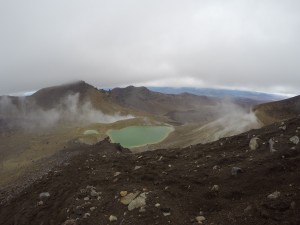
A German kid caught me talking to myself yesterday. It was my fault, really. I was trying to break a hypnotic trance-like repetition of exactly what I was going to say to the tramper’s hut warden about two hours away. OK, more specifically, I had left the Waihohonu camp site in Tongariro National Park at 7:30AM and was planning to walk out that day. To put this into perspective, it’s 28.8 km (17.9 miles) with elevation changes of around 900m, including a ridiculous final assault above red crater at something like 60 degrees along a stinking volcanic ridge line. And, to make things extra lovely, there was hail, then snow, then torrential downpours punctuated by hail again—a lovely tramp in the New Zealand summer—all in a full pack.
But anyway, enough bragging about my questionable judgement. I was driven by thoughts of a hot shower and the duck l’orange at Chateau Tongariro while my hands numbed to unfeeling arresting myself with trekking poles down through muddy canyons. I was talking to myself. I was trying to stop repeating to myself why I didn’t want my campsite for the night that I had reserved. This is the opposite of glorious runner’s high. This is when all the extra blood from one’s brain is obsessed with either making leg muscles go or watching how the feet will fall. I also had the hood of my rain fly up over my little Marmot ball cap. I was in full regalia, too, with the shifting rub of my Gortex rain pants a constant presence throughout the day. I didn’t notice him easing up on me as I carried on about one-shot learning as some kind of trance-breaking ritual.
We exchanged pleasantries and he meandered on. With his tiny little day pack it was clear he had just come up from the car park at Mangatepopo for a little jaunt. Eurowimp. I caught up with him later slathering some kind of meat product on white bread trailside and pushed by, waiting on my own lunch of jerky, chili-tuna, crackers, and glorious spring water, gulp after gulp, an hour onward. He didn’t bring up the glossolalic soliloquy incident.
My mantra was simple: artificial neural networks, including deep learning approaches, require massive learning cycles and huge numbers of exemplars to learn. In a classic test, scores of handwritten digit images (0 to 9) are categorized as to which number they are. Deep learning systems have gotten to 99% accuracy on that problem, actually besting average human performance. Yet they require a huge training corpus to pull this off, combined with many CPU hours to optimize the models on that corpus. We humans can do much better than that with our neural systems.
So we get this recently lauded effort, One-Shot Learning of Visual Concepts, that uses an extremely complicated Bayesian mixture modeling approach that combines stroke exemplars together for trying to classify foreign and never-before-seen characters (like Bengali or Ethiopic) after only one exposure to the stimulus. In other words, if I show you some weird character with some curves and arcs and a vertical bar in it, you can find similar ones in a test set quite handily, but machines really can’t. A deep learning model could be trained on every possible example known in a long, laborious process, but when exposed to a new script like Amharic or a Cherokee syllabary, the generalizations break down. A simple comparison approach is to use a nearest neighbor match or vote. That is, simply create vectors of the image pixels starting at the top left and compare the distance between the new image vector and the example using an inner vector product. Similar things look the same and have similar pixel patterns, right? Well, except they are rotated. They are shifted. They are enlarged and shrunken.
And then it hit me that the crazy-complex stroke model could be simplified quite radically by simply building a similar collection of stroke primitives as splines and then looking at the K nearest neighbors in the stroke space. So a T is two strokes drawn from the primitives collection with a central junction and the horizontal laying atop the vertical. This builds on the stroke-based intuition of the paper’s authors (basically, all written scripts have strokes as a central feature and we as writers and readers understand the line-ness of them from experience with our own script).
I may have to try this out. I should note, also in critique of this antithesis of runner’s high (tramping doldrums?), that I was also deeply concerned that there were so many damn contending voices and thoughts racing around my head in the face of such incredible scenery. Why did I feel the need to distract my mind from it’s obsessions over something so humanly trivial? At least, I suppose, the distraction was interesting enough that it was worth the effort.